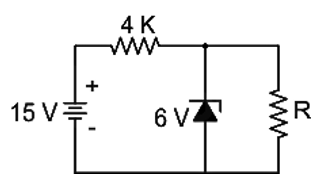In the circuit shown below the minimum value of R that will turn on the Zener is
Right Answer is:
2.67 kΩ
SOLUTION
The given circuit contains a 15V source, a 4kΩ resistor, and a 6V Zener diode in parallel with a variable resistor R. The task is to find the minimum value of R that will turn on the Zener diode.
Here’s how we can approach this problem:
Zener Diode Behavior:
- A Zener diode acts like a voltage regulator when it is reverse-biased and the voltage across it exceeds its breakdown voltage.
- Zener diode can be turned ON (conducts current) only if the voltage drop across it is equal to or greater than its Zener breakdown voltage.
- In this case, the Zener diode will start conducting when the voltage across it reaches 6V.
Circuit Analysis:
- To ensure that the Zener diode conducts, the voltage across it must be at least 6V.
- Since the Zener diode and resistor R are in parallel, they will have the same voltage across them.
- Therefore, we need to find the minimum value of R that will allow a 6V drop across it.
Calculating the Current:
- The total current flowing through the 4kΩ resistor and the Zener diode will be the same.
- We can calculate the current using Ohm’s law:
- I = (15V – 6V) / 4kΩ = 2.25 mA
Calculating the Minimum Value of R:
- Now that we know the current through R, we can use Ohm’s law again to find the minimum value of R:
- R = 6V / 2.25 mA = 2.67 kΩ
Therefore, the minimum value of R that will turn on the Zener diode is 2.67 kΩ.


